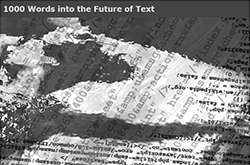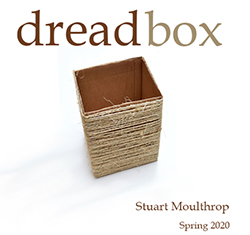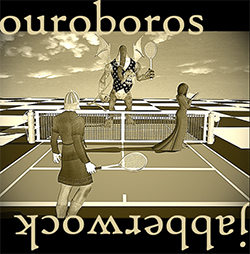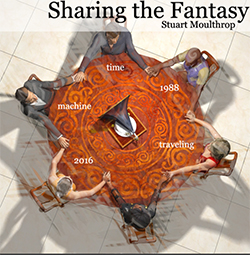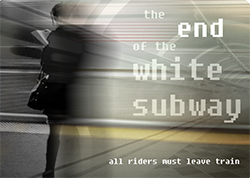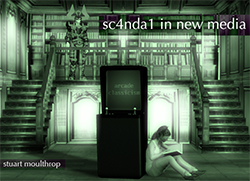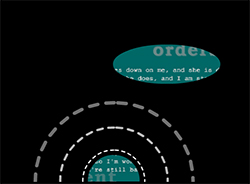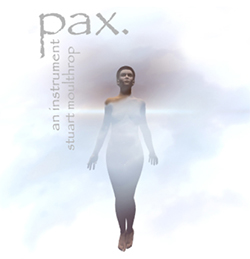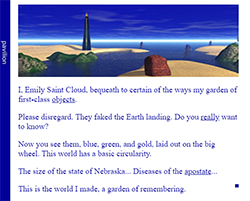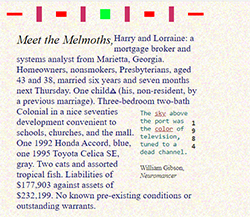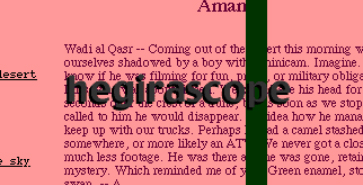The Works
This page lists works of electronic literature, art, or what-have-you, from 1991 to the present (reverse chronology).
Meccano No. 2 - Maga World
HTML/CSS/Javascript. Project available |here|.
This is a multi-level deconstruction of Julio Cortázar's Hopscotch on the occasion of its 60th anniversary. An endless scroll mixes deformed text from the novel (and other hoppy-scotchy texts) with pieces of an original short fiction. Selected for the Hops Ahead show at the 2022 International Conference on Interactive Digital Storytelling.
Victory Garden 2022 (ELO/The Next, 2022)
HTML/CSS/Javascript. Project available |here|.
This is a new version of my 1991 Storyspace fiction Victory Garden, redesigned in Web formats and available online. The narrative structure is unchanged, the text altered only sparingly, but the navigation scheme has received a serious overhaul, with a new reader interface designed by Andrew Thompson of the Electronic Literature Laboratory. There are also more than 150 new graphics.
An artist talk about the work is here.
1000 Words Into the Future of Text (The Future of Text, 2020)
HTML/Javascript. Project available |here|.
This substition grammar project was written when Frode Hegland, developer of the Liquid writing platform, asked for a contribution to a book on the Future of Text. The way I see it, text is kind of like a teenage child. It determines its own future. With not a lot of emphasis on responsibility, though in truth that's always the parent's fault, isn't it? The page will deliver either a nicely sized kiloword slice, or an unending stream of wordspew. Choose wisely.
Dread Box (The Digital Review, 2020)
Twine. Project available |here|.
This project began as one of the final exercises in my book with Anastasia Salter, Twining (2020), a simpler spatial riddle called Twine Box, which is also available |here|. Dread Box allows the player only a single traversal of the six (or seven) spaces (where its predecessor allowed for unlimited wandering), and on each stop challenges the player to find words that will justify a certain outcome -- hopeful, or something else.
Written in the new Chapbook story format, Dread Box is my first published Twine work.
Stromatolite (New River, 2020)
HTML/Javascript. Project available |here|.
During my flarfical work with Michael Joyce's "novel of internet" I discovered unexplained word-masses hovering at the statistically improbable edge of networked language. Though they are probably less mysterious than they seem (unless you believe in the Deep Web), they remain ineffable to me, and so the occasion for a poem in a dream in a verbal midden. Dig it!
Why 2K (Taper 2.0, 2018)
HTML/Javascript. Project available |here|.
This is a fairly simple substitution-grammar text generator written within a 2,000 kilobyte restriction on the code. Aside from the joy of constraint, this project provided yet another occasion for thinking about apocalypse, utopia, and why I seem to need to put a semicolon after every executable statement.
Ouroboros vs. Jabberwock (2017)
With Deena Larsen. HTML/Javascript. Project available |here|.
When a poet-hacker as brilliant as Deena Larsen proposes a joint project, you don't say no -- especially at a moment when lots of us needed something to take our minds off the world. Ouroboros vs. Jabberwock (or 'the O-J case,' as I would call it) started with a debate at ELO 2015 about... something. Deena could tell you. I've forgotten. What eventuated is a dual-stream presentation in which the reader is invited to attend either to Deena's side of things -- a looping, audible poem with discrete hyperlinks -- or mine, which uses sub-grammars to compile endless poetic matchups between the Heroic Youth and the Jabberwock... scored as a tennis match, of course. We had more fun making this thing than the world will ever understand.
Show's Over (Vassar Review, 2017)
HTML/Javascript. Project available |here|.
If progress, democracy, and civilization can be disrupted, why not fiction? This piece was written in the dire winter of 2016-17, when Michael Joyce invited topical pieces of digital production for a re-launch of the legendary Vassar Review. The pattern here is similar to White Subway, though in place of a gamified train ride there is a potentially endless scroll of imaginary movie credits. Or maybe a ride on the bus of doom. The reader presses a button to request a stop and receives a chunk of story in return. Someone in the TINAC circle actually had the idea for a cable television channel that would broadcast nothing but the credit rolls of (existing?) films. Michael Joyce says it as McDaid. McDaid says it was me. I blame Nancy. Anwyay, here's the demo.
Sharing the Fantasy (R-CADE Symposium, 2016)
HTML/Javascript (from HyperCard). Project available |here|.
John McDaid's multimedia hypernovel Uncle Buddy's Phantom Funhouse (Eastgate, 1995) contains the digital version of a science fiction convention program ("Spasticon '88"), including a panel called "Sharing the Fantasy" moderated by Stuart Moulthrop. So when James Brown, Jr. and Bobby Emmons invited me to a 2016 creative symposium on the Funhouse, the play was obvious: simulate the transcript of the imagined session using HyperCard. Which I was able to do, thanks to a much-faded copy of HyperTalk Programming and a 2004 PowerBook I scored from eBay. Explaining to airport security why I wanted to fly to Philadelphia with two laptops, one of them made in the Bush administration... that was also an occasion for storytelling. Anyway, the port from HyperTalk to JavaScript was dead simple -- so much has not changed -- and so we are able to experience the late eighties with all the comforts of web.
The End of the White Subway (New River, 2016)
HTML/Javascript. Project available |here|.
Emerging from a long stretch in which I was thinking and writing about stories and games, this HTML/Javascript project allows reader/players to prolong dwell state as long as they like. It takes us on a hallucinatory ride on the White Subway (a William S. Burroughs invention reframed by John McDaid), which continues until we decide to get off. Along the way, there are objects to inspect and collect, opportunities to ask for advice, and other occasions for metered behavior. There is also a story, in cut-scenes as it were, about descent, exploration, encounter, and dread. In the end, always, the score.
Deep Surface (Electronic Literature Collection, Vol. 2, 2013)
See the Note about Adobe Flash. Project available |here|.
For SWF File Player: download component files |here| (10.4 MB). Start with deepSurface.swf.
With Under Language, this project won the Ciutat de Vinarós prize, for fiction. It is nearly the most ambitious thing I built in Flash (eclipsed by Pax), using a stack of overlaid text-and-image layers through which the reader/player can sink and rise. I have called it the monstrous progeny of a reading machine and a free-diving simulator. Read, breathe, read some more... till robot voices wake you, and you drown. A certain sinister figure from early-2000s American politics is lurking in the depths... Times change.
SC4NDA1 in New Media (Dichtung Digital 2011)
Not currently available.
For a while I had this piece on the scholarly side of my CV, because it was submitted to a special issue of the German publication Dichtung Digital that invited formally experimental essays. Having recently been teaching basic 2-D animation with JavaScript to a bunch of bemused English majors, I did what came naturally: crossed an essay with a game of Pong. It turns out this is, according to Ian Bogost in Persuasive Games, the stupidest way to think about the intersection of prose and games. (And maybe he's right.) An astute Australian grad student pointed this out to me when I showed SC4NDA1 there. 'You were doing it deliberately, of course,' he said. Of course! Not. I read Ian's book years before attempting this piece and remembered everything he said about prose and Pong, except the part about how it shouldn't be done.
Oh well. There's your scandal. SC4NDA1 did give me an opportunity to experiment extensively with animated text effects in JavaScript, and with the pattern of interrupted linearity that has become my signature dish.
This project exists in both Flash and HTML/JavaScript versions. Sadly, neither runs reliably in contemporary browsers, so the project is offline until I can find time to rebuild it in proper HTML5.
Under Language (Iowa Review Web 2008)
See the Note about Adobe Flash. Project available |here|.
Courtesy of Dene Grigar and the Electronic Literature Lab at Washington State Vancouver, an emulated version is available. This version will run in any browser, no plug-in required.
For SWF File Player: download component files |here| (10 MB). Start with main.swf.
Under Language appeared in a special issue on "Instruments and Playable Texts," which I guest-edited. Poetry, proceeding at speed, meets programmatology, headed in an arguably different direction; after the catastrophe, the poem tells you what it thinks. Under Language was co-winner of the 2007 Ciutat de Vinarós Prize for Digital Poetry. If there were a prize for most bizarre use of ActionScript it might have been in contention there, too. Under Language is another Flash-based game, though one in which play consists of changing the game code.
Once again, there's a lot to be said for the dwell state.
Radio Salience (New River 2007)
See the Note about Adobe Flash. Project available |here|.
For SWF File Player: download component files |here| (37.3 MB). Start with starter.swf.
Radio Salience came from the same failed attempt at academic writing that produced Deep Surface and Under Language. This one is more than not-not a game, using actual matching logic to trigger transitions from a dwell state, in which slices of imagery flicker in and out, accompanied by a surreal collage of radio scanning, and a lock-in state in which a privileged text appears. An earlier draft, called "Human Voices," had the poetry in my own voice. I couldn't stand this and called in the robots. Except for Nick Montfort, who doesn't like robot voices, the world is happier.
The work has inspired enough interest to prompt a French translation, Empreinte radio, from Stefan Sobanski and Bleu Orange. The first time I showed this project, on a sneaky reappearance at an ELO gathering in 2006, it occurred to me that that dwell state may be a lot more fun than any of the resolutions. Truth dawns slowly for some. See End of the White Subway a few years later.
Marginal Effects: A Disorder of Attention (Tekka 2004)
See the Note about Adobe Flash. Project available |here|.
For SWF File Player: download component files |here| (4 MB). Start with mfx01.swf.
Marginal Effects was created before Pax, somewhere between 1998 and 2001. It appeared in the brief run of Mark Bernstein's online publication Tekka. Called "a disorder of attention," the work is about fragmentation and concealment, using a curious exploit in Flash to simulate portals into stacked layers of image and text. There are two of these peepholes, one cycling aimlessly around the screen, the other under player control. If in moving the controlled portal the player mouses over a link, a page transition results. Lots of fictive interruption in this one.
Pax, an Instrument (Iowa Review Web 2003)
See the Note about Adobe Flash. Project available |here|.
For SWF File Player: download component files |here| (8.65 MB). Start with main.swf.
Pax was published in Iowa Review Web and featured in +Game Engines+, the software exhibit at the 6th Digital Arts and Culture Conference. The work extends the 3D, multimedia aesthetic of Reagan Library in more ambitious directions, using human figures as animated sprites. Somehow clothes were optional (Nick Montfort said I should provide them as downloadable content).
As the date will indicate, Pax also reflects the spirit of the times after September 11, 2001. It is called "an instrument," in that sense of the other thing that can be played, besides games -- an insight I credit to John Cayley, though I am not sure he welcomes it. See Markku Eskelinen's Cybertext Poetics for an actual theory of textual instruments. I was just trying to build something that would behave unpredictably while following an overall deterministic path. Among other things, Pax was my first cybertext project with a defined runtime.
Pax was also an attempt to build an object-oriented multimedia work in a scripting language (ActionScript 2) not set up for object orientation. It can probably be rebuilt in HTML5, though Unity is also tempting.
Reagan Library (Gravitational Intrigue CD-ROM 1999)
See the Note about Adobe Flash. Project available |here|.
Reagan Library is a bimodal multimedia fiction that is (as N.K. Hayles likes to quote me saying) "not not a game." Which is to say, its visual/spatial aesthetic is heavily inspired by mid-90s adventure games, especially the Miller Brothers' MYST and Riven, and by my continuing love affair with 3D modeling software. The world of this text was made in an early version of Bryce. The clickable panoramas were originally created with Quicktime VR, converted to Flash when that technology was abandoned by Apple. Also notable here is an early use of randomized, replaceable text: the first time I had used this technique in published work.
The Color of Television (Media Ecology 1996)
HTML/Java. Available |here|.
I created this multi-threaded, verbal/graphic web fiction in collaboration with the writer and graphic designer Sean Cohen. It was published in the "Lab" section of an early on-line journal called Media Ecology. Gigantic background images (a Sean signature). Animated GIFs. A Java-based eraser puzzle from me. O that HTMLian rag. Color of Television underwent a technical overhaul in September, 2013 to correct broken links. The HTML remains anything but standard, but it should be readable.
Hegirascope (World 3 1995; New River 1997)
HTML. Available |here|.
What if the word will not be still? Or worse: What's in the trunk?. This was the next long-form project after Victory Garden, written in Sanibel, Florida in the summer of 1995. See remarks in the biographical sketch about "big, dumb riffs." This may have been my very first disruptive fiction. The second version was written after the original venue, World 3, went offline. Version 2 adds a few storylines (e.g., The Man Who Hates SUVs) and grants readers an additional 12 seconds to deal with them. For those who care (Mr. Kirschenbaum), the original version is |here|.
Dreamtime (Perforations 1992)
Dreamtime is a fugitive piece from my abortive multimedia fiction Chaos, which I started in 1988 when I first got hold of a Macintosh and HyperCard. It was published on diskette in Perforations, an Atlanta-based multimedia zine. The project is a HyperCard stack, and as such useable only to those with vintage hardware and software.
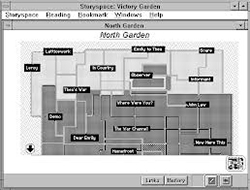
Screen capture of map from Victory Garden.
Victory Garden (Eastgate Systems, 1991)
This is a long-form hypertext fiction inspired partly by the homefront of the first Gulf War, and the Culture War that continues. Written in late beta versions of the Storyspace platform developed by Jay David Bolter, Michael Joyce, and John B. Smith, the work was published by Eastgate Systems and distributed initially on diskette and later CD-ROM. There appears to be no version that will run on contemporary computers. An excerpt made by the author in 1994 is on the Eastgate website (interesting perhaps in its own Web 1.0 way). A preservationist peformance or "traversal" of Victory Garden on a 1990s Macintosh can be viewed at the Pathfinders Project. Everlasting thanks to Dene Grigar.
This work is now accessible again through Victory Garden 2022.
Five of my projects -- Marginal Effects (2001), Pax (2003), Radio Salience (2007), Under Language (2008), and Deep Surface (2010) -- were made with Adobe Flash and depended on the Shockwave Flash browser plugin. Flash was a commercial product used to develop Web-based presentations popular in the first decades of the century. Browser support for the Shockwave Flash plugin officially ended in 2020. Flash works may still be still accessible in browsers and emulators, though results vary according to the complexity of the project. (My works are generally problematic.)
Under Language has been converted with the Conifer emulator and can be accessed here. For the other four works, I recommend running the primary Shockwave Flash file (.swf) with an Adobe-derived standalone player. You will need both the player software and the source files for the work in question. The source files are downloadable from the project listings on this page. Adobe no longer distributes standalone Flash players, but they are available from www.archive.org. For Windows, I recommend the last version of the player (32), which is available here. Click on the link for "Windows executable." For Mac OS, you'll probably want the complete Flash player package, available here.


